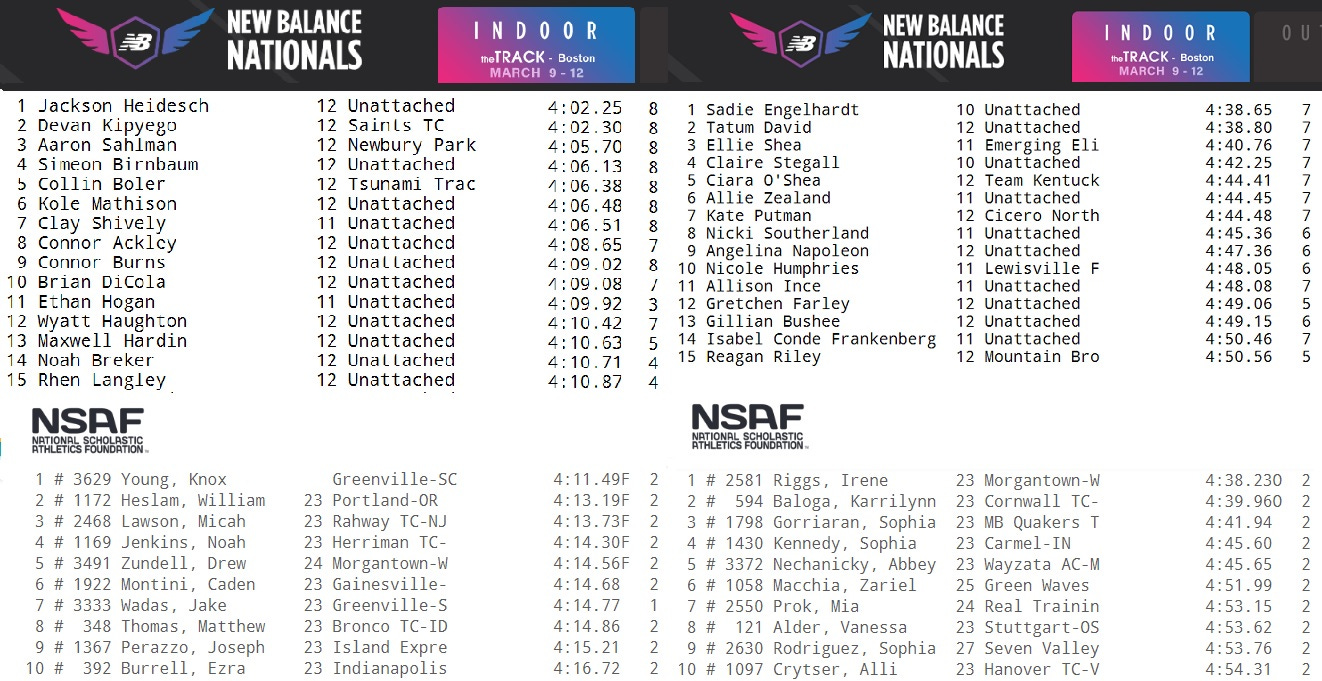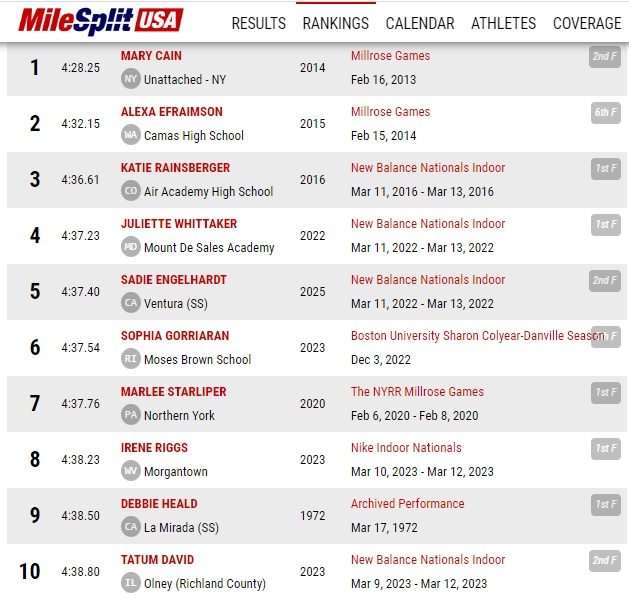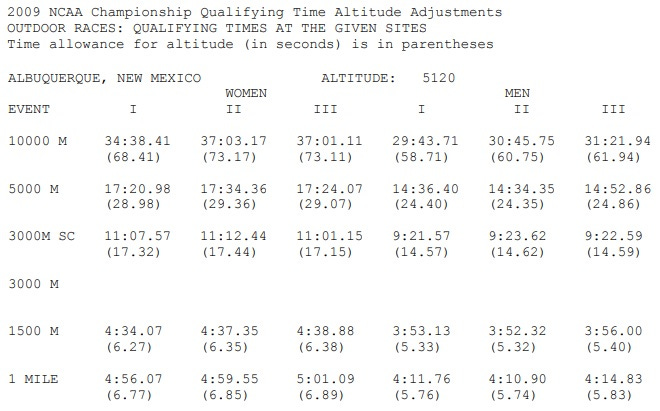So anyway, the NCAA D-I Championships and two high-school national championships took place over the weekend
A long-adored towhead becomes part of national record in the boys' 5,000 meters, while the NCAA men's 3,000 was under-the-radar incredible
The 2023 NCAA Division I Indoor Track and Field Championships took place on Friday and Saturday in Albuquerque, New Mexico (complete results). Meanwhile, two contemporaneous, and therefore competing, high-school national championships unfolded about 215 miles apart. The Nike Indoor Nationals, acknowledged by the National Scholastics Athletics Foundation (NSAF), were held at the Armory in New York City (results), while the New Balance Indoor Nationals took place in Boston at the recently completed The Track at New Balance (results).
Starting with the East Coast action, the results of the championship mile races underscore the talent imbalance, at least in the distance events: Most of the big high-school names, and far more bodies overall, made the trek to Boston’s version of a national prep championship.
Sadie Engelhardt is a freak even at a time when youngsters who until 2019 or so qualified as once-in-a-generation distance prodigies are emerging by the week. As a freshman last spring, she ran 4.11.79 for 1,500 meters, equivalent to a 4:31.94 mile. Her best time in a mile race is 4:35.16, and she ran 4:37.40 at the New Balance Indoor Nationals last year.
Her win last weekend didn’t budge her all-time U.S. #5 ranking in the event, but she pulled Tatum David into the all-time top ten, while Irene Riggs wound up the weekend #8 all-time thanks to her effort about four hours yonder.
Mary Cain’s triumphs and tragedies are well-chronicled. Alexa Efraimson graduated a year later than the Bronxville, New York star, and like Cain decided to sign a professional contract a with a year of high-school running remaining. Efraimson’s 4:07.05 1,500 meters in 2014, worth a 4:26.82 mile, put her in the same class as Cain.
Efraimson retired last November at age 25 after eight years with Nike. This made sense. Efraimson, who also ran 9:00.16 for 3,000 meters indoors in high school, can’t fairly be considered a flop, but she only improved by about a second per 400-meter lap in her small range of events. When she ran 4:07.05 for 1,500 meters, that put her at #54 all-time among Americans, and taking her personal best down to 4:03.39 as a pro only boosted her to #35 today.
Taking EPO would likely have gotten Efraimson below 4:00 and kept her career going if she hadn’t gotten caught. I bet she knows it, too. She may not have reached the world-class level, but she appears to have competed honorably and hard for as long as she was obligated to Nike. And Nike will never again sign a 4:03.39 woman past her 25th birthday.
Engelhardt is good enough now so that if she merely maintains and doesn’t backslide at all, she will be a contributing member of any NCAA program that takes her—if she goes that route. And it seems unlikely that she’s run one step as an NCAA athlete based on current trends.
Also in Boston, Massachusetts junior Ellie Shea, in addition to running a 4:40.76 mile (not a personal best), soloed a 9.49.82 two-mile to rise to #4 all-time. Shea seems almost destined to forgo the NCAA turn professional, given that, unlike Engelhardt, she doesn’t even run for a high-school team. And University of Oregon-bound Connor Burns of Missouri now stands #7 all-time indoors among U.S. schoolboys in that event after his 8:43.24 in Beantown.
Shea decided to add the 5,000-meter title to her efforts in Boston, winning that race by nearly a minute in 15:46.28, comparable to Katelyn Tuohy’s national record of 15:37.12. But the boys’ race was special, with Edward Cheserek’s 5,000-meter record falling to Tyrone Gorze.
Aidan Cox of New Hampshire wound up #9 all-time at the end of the day, leading a sizable contingent of Granite State runners (New Hampshire Track and Field write-up).
It will be strange, just really strange, when Aidan Cox becomes an adult. That won’t happen until August. But he has already rewritten the New Hampshire record books in his chosen sport, and not just as a high-school athlete—he’s been a force of some sort on the roads since Obama was in office.
Cox knows a lot of people are hooked on following his career. It’s all been fun to observe both up close and remotely, because Cox has a lot of fun doing what he’s doing.
The 2023 NCAA D-I Championships were at high altitude, around 5,120’ above see level (the data below pertain to the University of Mexico’s outdoor track). This means that the mile is “hypoxically penalized” in Walter White territory by about 2.27 percent, the 3,000 meters by about 2.70 percent, and the 5,000 meters by about 2.86 percent.
The men’s 3,000 meters was won by Oklahoma State’s Fouad Messaoudi in 7:48.10. That’s worth about 7:35.79 at sea level, almost two seconds better than Rudy Chapa’s NCAA record of 7:37.70 from 1979. And although Chapa is the only collegian to break 7:43 indoors, Messaoudi’s nearest three competitors all had converted times under Chapa’s mark. And all four of these guys have at least one season of eligibility remaining—in fact, three are listed as sophomores.
The only collegiate runner who actually set an NCAA record in a distance event this indoor season was N.C. State’s Tuohy, who set two of them, one with a 4:24.26 mile and the other with an 8:35.20 3,000 meters. Tuohy skipped the mile at the 2023 NCAA Indoor Champs, but left Albuquerque with titles in the 3,000 meters (9:10.07) and the 5,000 meters (16:09.65).
Those times translate to sea-level marks of 8:54.03 and 15:42.69, but the notable thing is that Tuohy is back to being the same runner she was early in her high-school career. Although no one beat her in her final year of high school, she started to have close calls. Then, after her NCAA debut was delayed by a combination of covid and injury, she returned as almost the runner she’d been, and now she’s far better.
The next time she runs an all-out 5,000 meters fit, she’ll have a good chance at breaking 14:50.






